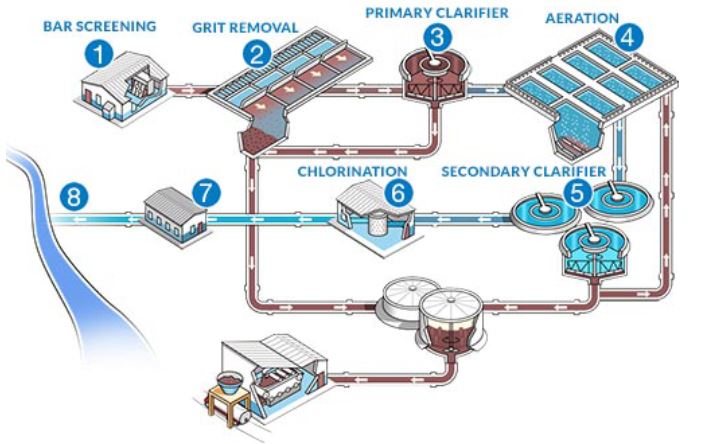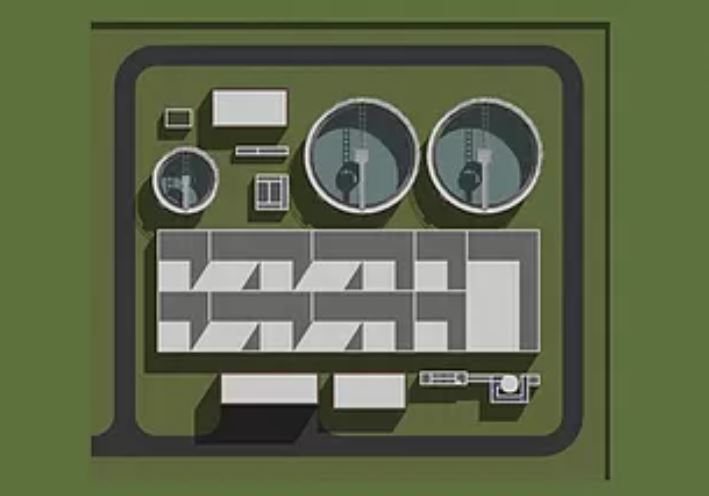In this article, we’ll look at three ways that wastewater can be cleaned up in environmentally friendly ways. We’ll consider:
- Common methods of wastewater treatment.
- Planning and design of treatment plants.
- Automation to manage these wastewater treatment processes and make them more effective, more efficient and less labor-intensive.
Wastewater Treatment Processes
The most common methods used for municipal wastewater treatment are
- Conventional activated sludge (AS, CAS)
- Membrane bioreactor (MBR)
- Moving bed biofilm reactor ( MBBR)
- Integrated fixed film activated sludge (MBBR IFAS, IFAS)
- Sequencing batch reactor (SBR)
The MBR method results in the cleanest effluent. It also is the highest energy-use method. Depending on the relative costs of construction vs, energy, construction and OPEX offset each other to varying degrees. Depending on the sensitivity of the site, the cleaner effluent may be a greater or lesser benefit.
Other options, such as CAS, are less expensive to operate. However, they don’t result in effluent as clean as MBR. They might be used in locations less sensitive to effluent quality. All of these systems have their benefits and limitations. Considering them, and selecting the appropriate one for a particular plant, is part of the design process.
Planning and Design of Wastewater Treatment Plants
Evaluating multiple process technologies in light of influent characteristics, effluent requirements, site restrictions and other factors for treatment plants is a complex process.
Life cycle analysis looks at changing needs. Do the character or volume of the influent or the effluent requirements change?
Other project criteria affect the design of the process and plant. How much space is available? Is odor control more, or less, important? Is the discharge area especially sensitive?
To accomplish this effective and efficient wastewater treatment process and plant design, expert and experienced plant and process design engineers are needed. Transcend Water’s water and wastewater engineers (turned computer programmers) have the expertise and experience you need for your plant and process design. Many disciplines, including process, mechanical and civil engineers, are represented on their capable team.All of these disciplines are employed in the automated WWTP design created by the Transcend Design Generator.
The TDG is an SaaS app that plant designers can employ to quickly develop a preliminary or conceptual plant design for their needs. It allows for quick changes in a design and for generating several options for a client to consider.
Since WWTP projects are always time-sensitive (We need it yesterday!), TDG’s ability to develop plant designs quickly is a great benefit to its users. Traditional engineering techniques can take hundreds of manhours. With the time pressure associated with these projects, it’s often difficult to fully consider many wastewater treatment process options with traditional methods.
Transcend’s wastewater treatment process designs evaluate all the process options we’ve discussed and, based on the outputs, the design engineers can select the one(s) that will meet a particular project’s needs. A complete set of engineering output documents can be created within a few hours,
Protecting the environment is a central focus of the TDG.
Automation
Automation can do many things for the wastewater treatment process.
Right from the beginning of a project, Transcend’s TDG was developed to automate the wastewater treatment process design. As we discussed earlier, this results in time-saving, and better consideration of process options.
Because many treatment plants operate in locations where the influent comes from households, the flow volumes and qualities can be very cyclical in nature. Constant monitoring and reporting of water quality with modern sensors and real-time online analysis provide plant operators the information they need to react accurately and make adjustments to the treatments.
Summarizing all these observations, humans need water. After they use water, it’s contaminated. Removing the contaminants with efficient and sustainable wastewater treatment facilities is life-saving for all of us.
Transcend Water leads the industry in automated wastewater treatment process design. To learn more and contact them to see how their WWTP design processes can work for you, check out their website.




